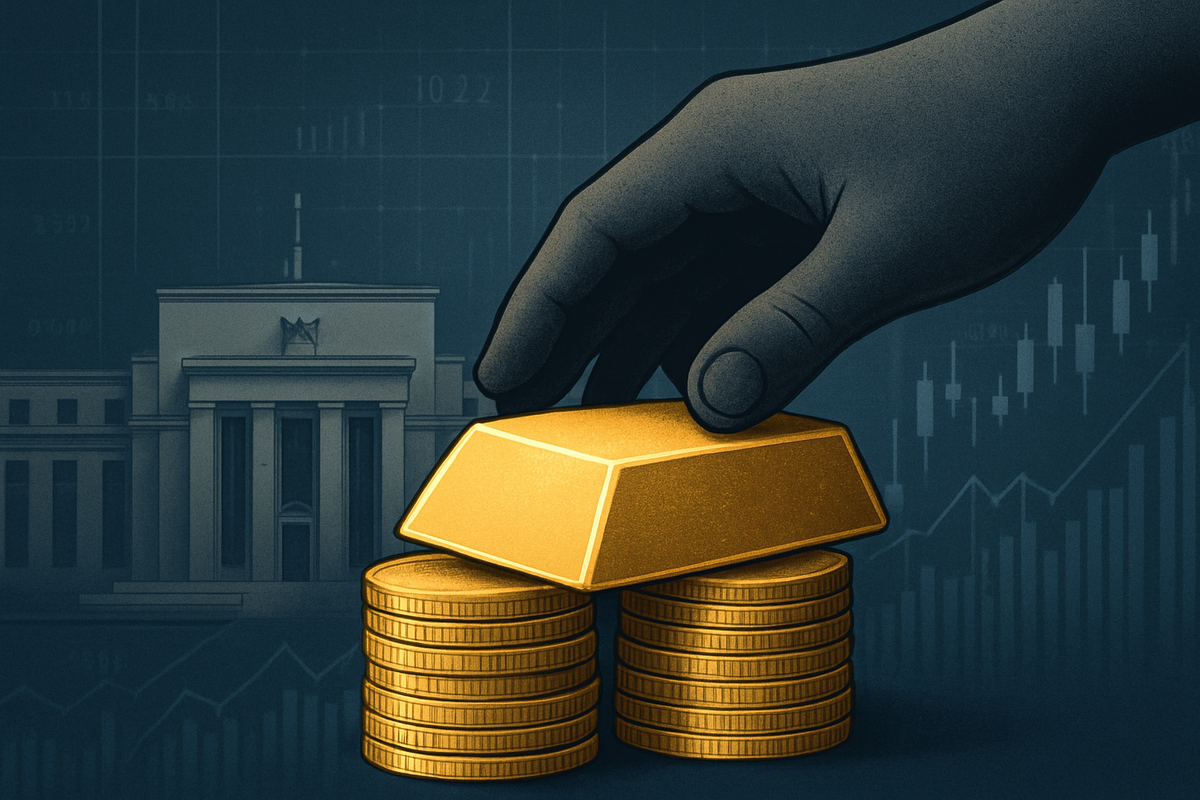
New York, NY – October 29, 2025 – In a move that initially spurred cautious optimism across financial markets, the Federal Reserve today delivered its second interest rate cut of 2025, lowering the benchmark federal funds rate by 25 basis points to a new target range of 3.75% to 4.00%. While such easing typically acts as a tailwind for gold, the precious metal, after an initial surge, conspicuously pared its gains, leaving investors questioning the true meaning behind the central bank's signals. The unexpected pullback highlights the nuanced and often contradictory interplay between monetary policy, central bank rhetoric, and the inherent allure of safe-haven assets.
The decision, coming amidst a backdrop of economic turbulence, including a recent government shutdown and ongoing trade tariffs, was not unanimous within the Federal Open Market Committee (FOMC), signaling a deeper division on the path forward. Gold, which has enjoyed a "golden rally" throughout 2025, hitting historic highs above $4,380 per ounce earlier in October, found itself caught in a tug-of-war between the immediate relief of lower rates and the sobering implications of Chair Jerome Powell's accompanying remarks.
The Fed's Double-Edged Sword: Rate Cut Meets Restrained Rhetoric
Today's 25 basis point reduction marks a continuation of the Fed's easing cycle, which began in late 2024 after a prolonged period of aggressive rate hikes. Following a 50 basis point cut in September 2024 and subsequent cuts in October and December of that year, the Fed had paused before resuming easing in September 2025 with another 25 basis point reduction. That September 17, 2025, cut was characterized by Powell as a "risk management cut" to prevent further labor market slowing, yet his comments were widely perceived as "not as dovish as the market had anticipated," already setting a precedent for restrained optimism.
The current rate cut was largely anticipated, leading to an initial positive reaction in gold prices, with spot gold briefly trading near $3,987.10 an ounce, up about 1%. However, the rally proved fleeting. During his post-meeting press conference, Chair Powell quickly tempered market enthusiasm by stating that expectations for a December 2025 rate cut were "not guaranteed," adding that the reality was "far from it." He acknowledged "strongly different" views among FOMC members and noted that while inflation remained "somewhat elevated," the majority of officials were more concerned about the labor market. These cautious remarks, signaling a potential slowdown in the pace of future easing, prompted swift profit-taking and a recalibration of investor sentiment, causing gold prices to hover around $3,950-$4,010, significantly below its mid-October peak.
Key stakeholders involved in this intricate dance include the Federal Reserve itself, particularly the FOMC and its Chair, Jerome Powell, whose every word is dissected by markets. Investors, both institutional and retail, play a crucial role through their demand for gold-backed instruments and physical bullion. Globally, central banks, which have been steadily increasing their gold reserves, also contribute to the metal's underlying demand, though their actions are more long-term. Commodity traders and analysts, by interpreting these signals, further amplify short-term price movements.
Navigating the Volatility: Implications for Gold-Related Companies
The immediate paring of gold's gains, despite a rate cut, introduces a layer of uncertainty for companies deeply entrenched in the precious metals sector. While sustained high gold prices earlier in 2025 provided a significant boost, increased volatility and a less clear path for future price appreciation could impact profitability and investor confidence.
Major gold mining companies, such as Newmont Corporation (NYSE: NEM) and Barrick Gold Corporation (NYSE: GOLD), thrive in environments of high and stable gold prices. While gold's year-to-date performance remains robust, any indication of slowing momentum or increased price swings could affect their revenue forecasts, capital expenditure decisions, and ultimately, their stock performance. Mining operations require substantial upfront investment, and a volatile gold market makes long-term planning more challenging. Similarly, companies like Agnico Eagle Mines Limited (NYSE: AEM) and Kinross Gold Corporation (NYSE: KGC), with significant production capacities, would prefer a clearer upward trajectory for the metal.
For investors seeking exposure to gold without direct physical ownership, gold-backed Exchange Traded Funds (ETFs) such as SPDR Gold Shares (NYSE Arca: GLD) and iShares Gold Trust (NYSE Arca: IAU) are popular vehicles. These ETFs directly track the price of gold, meaning their performance mirrors the metal's movements. When gold prices pare gains or experience significant pullbacks, these funds will reflect that decline, potentially leading to investor outflows or reduced interest. Companies specializing in gold streaming and royalties, like Franco-Nevada Corporation (NYSE: FNV), which benefit from a percentage of production or revenue, might see their future earnings projections impacted if the long-term outlook for gold becomes less bullish due to persistent central bank caution.
Wider Significance: A New Era of Central Bank Communication?
This event transcends mere price movements, offering a critical insight into the evolving dynamics of central bank communication and market interpretation. The Fed's balancing act between combating inflation and supporting employment has become increasingly complex. Powell's cautious tone, even after a rate cut, suggests a central bank wary of signaling an overly dovish stance, fearing a resurgence of inflationary pressures or an overheated market. This approach contrasts with earlier periods where rate cuts were often accompanied by overtly dovish forward guidance.
The ripple effects are likely to be felt across various asset classes. A less aggressive Fed outlook on future cuts could lead to a stronger U.S. dollar, making dollar-denominated gold more expensive for international buyers and potentially dampening demand. Bond markets, particularly shorter-term treasuries, might see yields stabilize or even rise if the market discounts further rapid easing. Other commodities, often influenced by the dollar and global economic sentiment, could also experience increased volatility. This scenario fits into broader industry trends where geopolitical tensions and economic uncertainty have pushed investors towards safe havens, but the efficacy of these havens is now being tested by the nuances of monetary policy.
Historically, gold has often rallied strongly in easing cycles, but this current situation presents a more intricate picture. The market is increasingly sensitive not just to the action of a rate cut, but to the language surrounding it. This shift demands a more sophisticated understanding of central bank signals, moving beyond simple rate adjustments to include the subtle cues on future policy direction. It underscores a potential new era where the Fed aims to manage expectations meticulously, avoiding both excessive exuberance and undue pessimism.
What Comes Next: Navigating Uncertainty
In the short term, markets are likely to remain highly sensitive to any further communications from Federal Reserve officials. Investors will be scrutinizing upcoming economic data, particularly inflation reports and labor market statistics, for clues on the Fed's next move. The possibility of a December rate cut, now explicitly "not guaranteed," will be a major point of contention and speculation, contributing to continued volatility in gold and broader financial markets.
Looking further ahead, the long-term trajectory for gold remains subject to a confluence of factors. Should inflation prove stickier than anticipated, or if geopolitical tensions (such as ongoing trade disputes or conflicts) escalate, gold's appeal as an inflation hedge and safe haven could reassert itself, potentially overriding the Fed's cautious stance. Conversely, a sustained period of economic stability and clear disinflation could lessen gold's allure, as investors shift towards higher-yielding risk assets. Strategic pivots for investors might involve re-evaluating the role of gold within diversified portfolios, perhaps focusing more on its long-term safe-haven properties rather than expecting continuous short-term rallies from rate cuts.
Potential scenarios range from a more prolonged pause in rate cuts, leading to gold consolidating around current levels, to a renewed aggressive easing cycle if economic conditions deteriorate significantly, which could reignite gold's upward momentum. Market opportunities may emerge for agile traders who can correctly anticipate the Fed's next moves, while challenges will face those expecting a straightforward correlation between rate cuts and gold appreciation.
Wrap-Up: The Nuance of Gold's Allure
Today's market reaction serves as a powerful reminder that in the complex world of finance, simple correlations often fall short. While a Federal Reserve rate cut traditionally bolsters gold prices by reducing the opportunity cost of holding the non-yielding asset, the nuanced communication from Chair Jerome Powell has demonstrated that the context and forward guidance accompanying such decisions are equally, if not more, impactful. Gold's initial rally and subsequent paring of gains underscore the market's sophisticated interpretation of central bank signals, where a less dovish-than-expected tone can quickly overshadow the immediate relief of an interest rate reduction.
Moving forward, the market will undoubtedly remain on high alert for further indications of the Fed's policy trajectory. The delicate balance the central bank is attempting to strike between managing inflation and supporting economic growth will continue to define the landscape for precious metals. Investors should focus on the underlying economic fundamentals, global risk sentiment, and critically, the entirety of the Federal Reserve's communication, rather than isolated policy actions. The lasting impact of this event lies in its reinforcement of the idea that in today's interconnected global economy, clarity in central bank communication is paramount, and even the most anticipated moves can yield unexpected outcomes when met with cautious rhetoric. What investors should watch for in the coming months are the minutes from FOMC meetings, subsequent speeches by Fed officials, and key economic indicators that will either confirm or challenge the market's current cautious outlook.
This content is intended for informational purposes only and is not financial advice





